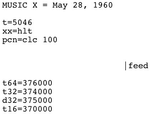
Harmony Compiler
Encyclopedia
Harmony Compiler was written by Peter Samson
at the Massachusetts Institute of Technology
(MIT). The compiler was designed to encode music for the PDP-1
and built on an earlier program Samson wrote for the TX-0
computer.
 ]
]
Jack Dennis
noticed and had mentioned to Samson that the sound on or off state of the TX-0
's speaker could be enough to play music. They succeeded in building a WYSIWYG
program for one voice before or by 1960.
For the PDP-1 which arrived at MIT in September 1961, Samson designed the Harmony Compiler which synthesizes four voices from input in a text-based notation. Although it created music in many genres, it was optimized for baroque music. PDP-1 music is merged from four channels and played back in stereo. Notes are on pitch and each has an undertone. The music does not stop for errors. Mistakes are greeted with a message from the typewriter's red ribbon, "To err is human, to forgive divine."
Samson joined the PDP-1 restoration project at the Computer History Museum
in 2004 to recreate the music player.
Peter Samson
Peter R. Samson is an American computer scientist, best known for creating pioneering computer software....
at the Massachusetts Institute of Technology
Massachusetts Institute of Technology
The Massachusetts Institute of Technology is a private research university located in Cambridge, Massachusetts. MIT has five schools and one college, containing a total of 32 academic departments, with a strong emphasis on scientific and technological education and research.Founded in 1861 in...
(MIT). The compiler was designed to encode music for the PDP-1
PDP-1
The PDP-1 was the first computer in Digital Equipment Corporation's PDP series and was first produced in 1960. It is famous for being the computer most important in the creation of hacker culture at MIT, BBN and elsewhere...
and built on an earlier program Samson wrote for the TX-0
TX-0
The TX-0, for Transistorized Experimental computer zero, but affectionately referred to as tixo , was an early fully transistorized computer and contained a then-huge 64K of 18-bit words of magnetic core memory. The TX-0 was built in 1955 and went online in 1956 and was used continually through the...
computer.

Jack Dennis
Jack Dennis
Jack Dennis is a computer scientist and retired MIT professor.Dennis entered the Massachusetts Institute of Technology in 1949 as an electrical engineering major; he received his MS degree in 1954, and continued doctoral research and received his ScD in 1958...
noticed and had mentioned to Samson that the sound on or off state of the TX-0
TX-0
The TX-0, for Transistorized Experimental computer zero, but affectionately referred to as tixo , was an early fully transistorized computer and contained a then-huge 64K of 18-bit words of magnetic core memory. The TX-0 was built in 1955 and went online in 1956 and was used continually through the...
's speaker could be enough to play music. They succeeded in building a WYSIWYG
WYSIWYG
WYSIWYG is an acronym for What You See Is What You Get. The term is used in computing to describe a system in which content displayed onscreen during editing appears in a form closely corresponding to its appearance when printed or displayed as a finished product...
program for one voice before or by 1960.
For the PDP-1 which arrived at MIT in September 1961, Samson designed the Harmony Compiler which synthesizes four voices from input in a text-based notation. Although it created music in many genres, it was optimized for baroque music. PDP-1 music is merged from four channels and played back in stereo. Notes are on pitch and each has an undertone. The music does not stop for errors. Mistakes are greeted with a message from the typewriter's red ribbon, "To err is human, to forgive divine."
Samson joined the PDP-1 restoration project at the Computer History Museum
Computer History Museum
The Computer History Museum is a museum established in 1996 in Mountain View, California, USA. The Museum is dedicated to preserving and presenting the stories and artifacts of the information age, and exploring the computing revolution and its impact on our lives.-History:The museum's origins...
in 2004 to recreate the music player.

